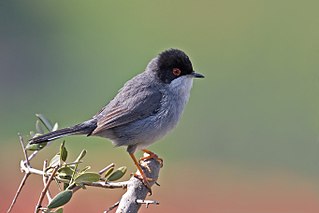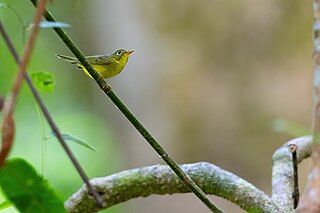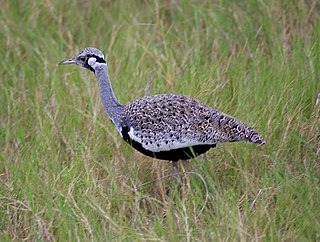
Prinia is a genus of small insectivorous birds belonging to the passerine bird family Cisticolidae. They were at one time classed in the Old World warbler family, Sylviidae.

The family Cisticolidae is a group of about 160 warblers, small passerine birds found mainly in warmer southern regions of the Old World. They were formerly included within the Old World warbler family Sylviidae.

The Sardinian warbler is a common and widespread typical warbler from the Mediterranean region. Like most Curruca species, it has distinct male and female plumages. The adult male has a grey back, whitish underparts, black head, white throat and red eyes. Plumages are somewhat variable even in the same locality, with the intensity of a reddish hue on upper- and/or underside that varies from absent to pronounced. The female is mainly brown above and buff below, with a grey head. The Sardinian warbler's song is fast and rattling, and is very characteristic of the Mediterranean areas where this bird breeds.

The tawny-flanked prinia is a small passerine bird belonging to the genus Prinia in the family Cisticolidae, a family of Old World warblers. It is widespread and common in most parts of Africa south of the Sahara. The plain prinia of southern Asia was formerly included in this species but is now usually considered to be a separate species.

The Senegal eremomela is a member of the African warbler family, the Cisticolidae. It occurs in the savannas of western Sub-Saharan Africa.

The Karoo chat is a small passerine bird of the Old World flycatcher family Muscicapidae. It is a common resident breeder in southwesternmost Angola, western Namibia and western South Africa. Its habitat is Karoo and desert scrub in the south, extending to the escarpment zone in the north.
The red-capped forest warbler, also known as the African tailorbird, is a songbird of the family Cisticolidae, formerly part of the "Old World warbler" assemblage. It is found in Mozambique and Tanzania. Its natural habitat is subtropical or tropical moist montane forests from 1600 to 2500 m.

The black-headed tailorbird, also known as the white-browed tailorbird, is a species of songbird in the cisticola family, Cisticolidae. First formally described by the Scottish ornithologist Arthur Hay in 1877, it is endemic to the southeastern Philippines, where it is found on the islands of Mindanao, Dinagat, and Siargao. It inhabits dense undergrowth in lowland forests at elevations of up to 1,000 m (3,300 ft).

Alström's warbler, or the plain-tailed warbler, is a species of Old World warbler in the family Phylloscopidae. It was first described in 1999. It breeds only in China and winters as far as Thailand, Laos, Cambodia and Vietnam. Its natural habitat is temperate forests.

The red-thighed sparrowhawk, alternatively known as the red-legged sparrowhawk or western little sparrowhawk, is a species of sparrowhawk in the family Accipitridae from western and northern central Africa. This species was formerly placed in the genus Accipiter.

Hartlaub's bustard is a species of bird in the family Otididae. It is a medium-sized bustard with a long, think neck, and long legs. It is found in open, tall grassland, range from 1600 meters to 2000 meters in Ethiopia, Kenya, Somalia, Sudan, Tanzania, and Uganda.

The grey-capped warbler is a species of bird in the family Cisticolidae. It is monotypic in the genus Eminia. The grey-capped warbler is found in Burundi, Democratic Republic of the Congo, Kenya, Rwanda, South Sudan, Tanzania, and Uganda. It is a large, chunky, thin-tailed-warbler with a distinctive grey cap, a black band around its head, and a chestnut throat wrapping its neck. Grey-capped warblers maintain a diet of insects and other invertebrates, including caterpillars, moths, grasshoppers, and mantids.

The red-winged prinia or the red-winged warbler is a bird species in the family Cisticolidae. It formerly belonged in the monotypic genus Heliolais. It is found in Benin, Burkina Faso, Cameroon, Central African Republic, Chad, Democratic Republic of the Congo, Ivory Coast, Ethiopia, Gambia, Ghana, Guinea, Guinea-Bissau, Kenya, Liberia, Malawi, Mali, Mozambique, Niger, Nigeria, Senegal, Sierra Leone, Sudan, Tanzania, Togo, Uganda, Zambia, and Zimbabwe, where its natural habitat is dry savanna.

Emin's shrike is a species of passerine bird in the family Laniidae, the shrikes. This species has a scattered distribution across Africa from the Ivory Coast east to South Sudan and Uganda.

The ashy flycatcher is a species of bird in the Old World flycatcher family Muscicapidae. It is found throughout sub-Saharan Africa, excluding the drier areas of South Africa, Botswana, and Namibia, where it inhabits subtropical or tropical dry forest, subtropical or tropical moist lowland forest, and savanna. It has a disputed generic placement, with different authorities variously putting it in Muscicapa, Fraseria, or other genera. Ashy flycatchers are mostly grey in colour, with pale grey or white underparts, and display no sexual dimorphism.

Roberts's warbler, also known as Roberts' prinia, briar warbler or brier warbler, is a species of passerine bird belonging to the family Cisticolidae. This species is endemic to the Eastern Highlands of Zimbabwe and Mozambique. Its natural habitats are subtropical or tropical moist montane forest and subtropical or tropical moist shrubland. It is the only species in the genus Oreophilias.

The cricket warbler, also known as cricket longtail, scaly longtail or cricket prinia, is a species of bird in the family Cisticolidae. It belongs to the genus Spiloptila; it is often the only species included in the genus but sometimes the red-fronted prinia is placed there as well.

The red-fronted prinia, also known as the red-fronted warbler and the red-faced apalis, is a species of bird in the family Cisticolidae. It is found in Chad, Djibouti, Eritrea, Ethiopia, Kenya, Somalia, Sudan, Tanzania, and Uganda. Its natural habitat is dry savanna.

The African warblers are a newly erected family Macrosphenidae, of African songbirds. Most of the species were formerly placed in the Old World warbler family Sylviidae, although one species, the rockrunner, was placed in the babbler family, Timaliidae. A series of molecular studies of the Old World warblers and other bird families in the superfamily Sylvioidea found that the African warblers were not part of Sylviidae but were instead an early (basal) offshoot of the entire clade Sylvioidea. Some taxonomic authorities place the entire family Hyliidae here.

The gray hawk or Mexican goshawk is a smallish raptor found in open country and forest edges. It is sometimes placed in the genus Asturina as Asturina plagiata. The species was split by the American Ornithological Society (AOU) from the gray-lined hawk. The gray hawk is found from Costa Rica north into the southwestern United States.




















